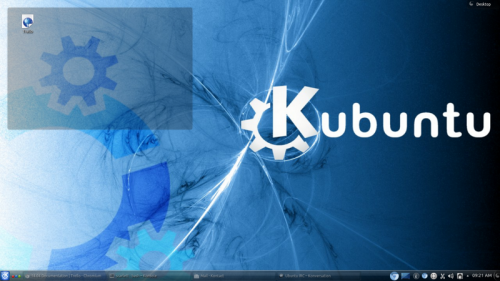Kubuntu/Podstawy
Ta część Dokumentacji obejmuje komponenty w ramach Kubuntu, które spełnią twoją pożądaną funkcjonalność i dostosują Kubuntu do twoich potrzeb.
Networking
This section will help you connect to the internet.
Wired
In most cases the wired network connection will simply work without any changes to the default Kubuntu configuration. Wired network connections are selected as default when they are available.
Wireless
Most wireless cards are supported out of the box by Kubuntu. However, in some cases, the wireless network device may need a restricted driver in order to operate. The best way to check this is to open the jockey-kde application (also known as 'Additional Drivers'). To open this program, click the Kickoff Launcher and search for Additional Drivers. If the device needs a restricted driver, then jockey-kde can help with selecting, installing, and activating the proper driver. Once this is all handled, the system will need to be rebooted. For more information on troubleshooting Wi-Fi on your system, see Wireless Troubleshooting.
Launchers
Kickoff
As a KDE distribution, Kubuntu uses the Application Launcher by default. The Launcher can be compared with the 'Start Menu' in Windows (pre Windows 8). The icon to launch is on the bottom left very much like Windows XP or 7. For more information on how to use and customize it, see Plasma Kickoff.
KRunner
Podobnie jak jest aktywatorem, ale potrafi on o wiele więcej niż uruchamianie aplikacji. Zazwyczaj jest dostępny po naciśnięciu Alt + F2. Aby uzyskać więcej informacji o tym co on potrafi, zajrzyj na stronę Plasma Krunner.
Desktop Customization

ThemesKubuntu allows themes to be changed easily. Open and choose in the section, then choose from the list of installed themes. You can change the theme of the Window Decoration, Cursor Theme, Desktop Theme, and the Splash Screen. Pick from the default choices that are installed, or left-click the 'Get New...' button in each section for more choices. PlasmoidsPlasmoids (also called Widgets) can be added by right-clicking the desktop and selecting , which will bring up a list of Widgets. For more information, see Plasma Widgets.
PanelBy right-clicking on the desktop once again, you can select to get more panels. You can left-click the button on the far right side of the panel to alter the properties of the panel, like changing its height or width or adding Widgets, for example. For more information, see Plasma Panels. DolphinDolphin is the default file manager in Kubuntu and can be compared with Windows Explorer. Dolphin looks simple because of great design, while having many powerful features. For more information, see Dolphin. UpdatingKubuntu developers release feature and security updates for applications and packages within the Kubuntu system. When updates become available, Kubuntu will display a message in the System Tray. To update the system, open and click the button. After installing some updates, it may be necessary to restart the computer. If so, Kubuntu will display a pop-up and an icon in the System Tray. |
